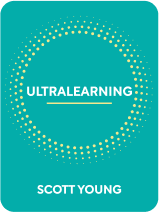

This article is an excerpt from the Shortform book guide to "Ultralearning" by Scott Young. Shortform has the world's best summaries and analyses of books you should be reading.
Like this article? Sign up for a free trial here .
What are the nine Ultralearning principles? How can following these principles help you learn more efficiently?
The nine principles of Ultralearning are metalearning, focus, directness, drill, retrieval, feedback, retention, deeper knowledge, and experimentation. Applying these principles to your studies will help you learn skills better than you would at college.
Keep reading to learn more about the nine Ultralearning principles.
What Are the 9 Principles of Ultralearning?
There are nine Ultralearning principles critical to success.
Principle #1: Metalearning
The first Ultralearning principle is called Metalearning. Metalearning is the process of figuring out how to learn a subject or skill. The process has three steps.
- Why: Determine your learning goal and ask yourself why you’ve chosen it. Your motivation will generally be either instrumental (characterized by the desire to achieve an external result), or intrinsic (characterized by the desire to learn something for personal enjoyment).
- What: Ask yourself what you need to learn to achieve your learning goal. Break your topic down into facts (pieces of information that simply need to be memorized), concepts (pieces of information that require deeper understanding than facts), and procedures (anything you need to practice to understand), and list everything relevant to learn in each category. Use this information to identify critical areas of focus for your learning.
- How: Explore how others have learned what you wish to learn and identify repeating strategies to use. Alternatively, identify the most critical parts of your skill or topic and rigorously evaluate your current learning approach to be sure it supports those components.
Principle #2: Focus
Deep learning requires deep focus. Ultralearners often confront three main obstacles when mastering concentration.
- Procrastination—Procrastination is knowing you need to do something, but avoiding it or doing something else instead. To overcome procrastination, use deliberate methods for resisting the impulse, like setting a timer, pushing yourself to work until that point, then steadily increasing the time. The approaches that best support concentration (and retention) are focusing for shorter time periods (20-50 minutes) or longer periods during which you switch tasks.
- Distraction—If you’re able to sidestep procrastination, you may still be distracted by your environment, the complexity or difficulty of a given task, or your own negative thoughts or circumstances. Practice mindfulness to maintain a relaxed mental state and take note of what environment is most productive for you so you can create it deliberately. For example, if you know that noise is distracting for you, work in quiet environments.
- Poor Optimization—Focus is influenced by arousal (how alert and energized you are): With low arousal, you’re less alert, and with high arousal, you’re more alert. High arousal is effective for simple activities requiring lots of energy (like sports). Complex tasks are best served by environments that induce low arousal, like working in silence or listening to soothing music. Low arousal keeps your mind relaxed enough to take in new ideas and information.
Principle #3: Directness
Directness is the idea that you learn a skill best when you practice it in the environment you plan to use it in. Practice directness with four tactics.
- Learning Projects—Projects are more valuable for practicing directness than classes because a project requires you to create a result and this requires a deeper understanding of what you’re learning. For example, if you’re learning animation, create an animated short film.
- Immersion—Immersion involves practicing your new skill or knowledge in unpredictable, real-life scenarios that you would never encounter in a traditional learning setting like a classroom. For example, you might learn a new language by spending three months in the native country of the language.
- Simulation—Sometimes, you won’t be able to directly access or replicate the real-life scenario you intend to use the skill in. In this case, simply replicate the “cognitive features” (the aspects of the experience with the strongest influence on performance) from the real experience. For example, if you want to win a trivia-based game show, you might find out what questions have been asked on the show in the past, study them, then practice with a buzzer in front of an audience of your peers. Although you can’t replicate the show’s environment exactly, you expose yourself to the key elements you’ll experience during the real show.
- Overachievement—Find out how you want to use what you’re learning and what environment you want to use it in, then practice in an environment that will demand the highest proficiency level of the skill you’re mastering. This helps you to learn at a deeper level long-term. For example, if you want to master painting, rent a studio for an art exhibition. If you know you’re going to be putting your paintings on display, you may push yourself harder to learn.
Principle #4: Drill
Drilling is isolating a weakness in your learning process and concentrating intensively on it. The aspect you isolate will be an integral component of the overall skill or subject, and in mastering it, you improve overall proficiency. The purpose of a drill is to unblock areas of learning that are impeding overall progress. They address the most difficult aspects of the process, reduce delays, teach you to confront your weaknesses and show you how to work through frustration.
Ultralearners utilize the principle of directness in tandem with drilling, in a “direct-drill-direct” process:
- Practice your skill in the direct context you want to apply it in.
- Identify aspects of the skill that are critical, or weak links in the process, and use drills to improve those isolated aspects.
- Integrate improved isolated skills by completing direct practice again, utilizing all aspects of the skill. This step allows you to determine if your drill method helped you to achieve the improvement you wanted.
Principle #5: Retrieval
Retrieval is the process of recalling information we’ve stored in our memory. Self-testing is one of the most direct ways to learn information (especially if it replicates the actual environment you’ll be applying the learning in). Research shows that when given the choice between reviewing existing material and testing yourself from memory alone, testing yourself is your best study tool. Self-testing is effective because by asking yourself questions and checking your answers afterward, you’re giving yourself feedback and training your brain to better retrieve the information later.
Psychologist R.A. Bjork’s concept of desirable difficulty theorizes that you retain information better if you give yourself time between study and active recall because answers are a little more difficult to recall after a small delay, and this mental challenge improves learning. Ultimately, when considering study methods, you want retrieval to be difficult but not so difficult that you can’t access the information at all. Find the middle ground.
Methods for practicing retrieval:
- Use visual association cues, like flashcards. This method works best for simple information. For example, it’s useful to make flashcards for memorizing vocabulary for a new language. However, it’s less useful to make flashcards for complex concepts like quantum theory.
- After you study a piece of information, practice writing down as much as you can remember in a notebook. Forcing yourself to retrieve the information this way makes it easier to recall later.
- Instead of traditional note-taking, write down targeted questions to test yourself on later. For example, instead of writing, “Obama became president in 2008,” write, “Who became president in 2008?”
Principle #6: Feedback
The difference between ultralearners and traditional learners is that ultralearners seek intense feedback. For example, if an ultralearner is trying to master public speaking, they might choose to practice speaking in front of the most challenging audiences immediately (for example, an audience of middle schoolers tends to be brutally honest).
What Are the Least and Most Valuable Types of Feedback?
The least valuable type of feedback is feedback that appeals to your ego. For example, praise is a popular form of feedback that makes people feel good but is harmful to the learning process because it is an assessment of you as a person, not a constructive assessment of your skills. Negative feedback from peers or teachers can also feel discouraging and impede learning.
The most valuable type of feedback is corrective feedback, which tells you what you’re doing incorrectly and tells you directly how to fix it.
How Can You Maximize Feedback?
To maximize feedback, try the following methods:
- Whenever you receive feedback, categorize it as “signal” or “noise.” Signal is the information that is valuable to your learning, and noise is nonconstructive feedback you should ignore. You can determine what is noise by evaluating the context of the feedback. For example, if no one is reading your new blog post, is that feedback on your writing “signal” or “noise”? If your blog doesn’t show up in a Google search, or social media algorithms bury it amongst blog posts of competitors, this isn’t valuable feedback on the quality of your writing.
- Put yourself in situations where you’re not sure if you will thrive or crash and burn. This will provide you with the most valuable feedback. If you find yourself failing too often, downgrade the difficulty level of the task or environment; if you are succeeding too often, upgrade the difficulty level.
Principle #7: Retention
The “forgetting curve” suggests that your retention of knowledge increases right after you’ve learned the information, then plateaus and tapers off. For example, the farther a doctor gets from his medical education, the more likely he is to forget what he learned (even though he’s been working long hours in a hospital).
Whether or not you retain something is dependent on your retention strategies. Consider the following approaches.
- Overlearning—To overlearn something is to excessively practice it. Studies show that even just a small amount of overlearning practice results in 1-2 weeks of further recall. Use the following steps.
- Select a simple learning task for yourself (for example, changing a tire).
- Practice this task until you are able to do it correctly once. This is the “learning” stage.
- Practice the task multiple additional times. This is the “overlearning” stage.
- Spacing—Spacing is engaging in multiple learning periods with significant time gaps in between. When you learn over spaced-out time periods, you may initially see discouraging results, but the process will support long-term retention because you continue to revisit the material you’re learning. However, the more space you have between study sessions, the less information you will retain, so the increments of time between study and retrieval need to be appropriately spaced and consistent. Spacing that allows enough time to elapse that retrieval of information is a challenge, but not so much time that you can’t access it at all, is ideal. Experiment with different periods of time between study and attempts to retrieve.
Principle #8: Deeper Knowledge and Intuition
Experts seek detailed understanding of ideas and principles. When you have enough experience and knowledge related to a problem, you are better equipped to think of novel ways to solve it. There are four critical rules to developing deeper knowledge.
- Let Yourself Struggle—Force yourself to struggle when you encounter a difficult problem or obstacle to your learning goal. Struggle is beneficial because most problems can be solved with enough thought and effort and deliberate struggle creates deeper understanding of the problem and builds resilience, leading to more efficient problem-solving later. Encourage this by setting a timer for 10-15 minutes and pushing yourself to work on the problem at least until the timer goes off.
- Aim to Prove—Always ask yourself, “Do I understand this well enough to explain how it works?” We often think we understand things when in reality we have only a partial or rudimentary understanding. This impedes deep learning, because if you don’t know the depth of your comprehension, you may assume you understand what you’re learning more than you actually do. For example, you might think you understand what a bicycle is and how it works, but if you were asked to draw a detailed picture of the mechanisms, you might falter. Aim to prove your understanding when you first learn something because it helps you develop a deeper knowledge base on that subject.
- Challenge Your Understanding—Make sure your learning standards are strict and high. Frequently question yourself. When you don’t ask questions out of a desire to “feel good” about your knowledge level, you rob yourself of deeper learning, and your overall knowledge suffers because you are able to more easily convince yourself you know enough.
- Prioritize Concrete Examples—The human brain understands abstract information better when it’s connected to concrete examples. Additionally, when you personalize those concrete examples, you retain information at a deeper level. For example, say you’re studying the periodic table of elements (abstract information) using flashcards. You might connect the abstract information to something concrete by imagining something you’d do with each element. For instance, for copper, you might imagine making a penny out of copper.
Principle #9: Experimentation
The final Ultralearning principle is experimentation. There is ample evidence that experimentation unlocks mastery. For example, van Gogh is one of the most eccentric painters in history. Notable in his learning approach is a diverse set of self-directed, experimental methods, perspectives, and materials.
The Benefits of Experimentation
- Experimentation Leads to Personalized Learning—When you first learn something, set yourself up by following in the footsteps of someone who has been learning it longer. Experiment with their materials and techniques. As you gain proficiency, there will be fewer people who have something to directly teach you. This will give you the opportunity to experiment outside of your comfort zone, leading you to a more personalized path to mastery. A path that is personalized to you is more efficient and leads to greater originality.
- Experimentation Leads to Efficiency—Once you have progressed in proficiency, review and refine your body of knowledge, as well as your strategies for achieving your learning goals. This is a process of “unlearning” and often involves taking exploratory risks to determine new or better ways to meet your goals. For example, if you’re learning public speaking and you usually practice in front of young adults, you might try practicing in front of elderly audiences. This supports learning efficiency by forcing you to adapt to new and different audience expectations.
- Experimentation Leads to Originality—Proficiency is not the only important aspect of mastery. Originality is another marker, and originality requires creativity, which requires experimentation.
Types of Experimentation
There are three main types of experimentation.
- Resources—This involves experimenting with materials, strategies, and other learning resources. The differences among them can lead to valuable learning insights. For example, if you’re learning to draw with pencil, you might take some time to experiment with charcoal or pen, and this gives you insight on how different drawing materials might affect your technique or style.
- Technique—Shift from “How can I learn this?” to “What should I learn next?” Determine a subtopic or sub-skill and spend time intensively learning it, then analyze your results. For example, if you are learning how to box, and you want to develop more of your own style, you might experiment with learning gymnastics, then review its impact on your boxing.
- Style—All styles have their pros and cons. Evaluate your personal strengths and weaknesses and test various styles to see which ones complement your learning style and which clash. Study the styles of experts for ideas of what to experiment with.
Methods of Experimentation
Try the following three methods to explore experimentation.
- Replicate Others—Replication gives you a place to start as you seek to expand your understanding of a skill and helps narrow down further avenues of exploration to personalize evolving skill sets. For example, van Gogh learned by copying the methods and styles of other artists, and once he gathered enough information, he personalized his style.
- Create Constraints—Constraints force you to move outside your comfort zone to learn in new ways, and this enhances your proficiency. For example, if you’ve reached proficiency in a new language by practicing with bilingual mentors, step out of your comfort zone by adding the constraint to practice with speakers who don’t speak your native language.
- Diversify Skills—Select an additional skill to practice that is seemingly unrelated to a skill you’ve already become proficient in. Proficiency in both skills can give you a competitive advantage. For example, if you’re a nurse, you might take up painting, creating a niche for yourself that intersects health with the arts. If a job arises that focuses on health and the arts, you are uniquely qualified over others who do not have experience in that niche.

———End of Preview———
Like what you just read? Read the rest of the world's best book summary and analysis of Scott Young's "Ultralearning" at Shortform .
Here's what you'll find in our full Ultralearning summary :
- How a formal education doesn’t open the doors it once could
- The 9 core principles that can help you master any skill
- How to create a self-directed learning project to help you advance in your field






